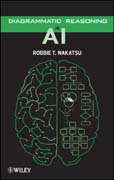
This book will describe graphical techniques that may be employed to increasethe transparency and flexibility of an intelligent system. The author definesan intelligent system as one that provides advice to end-users to aid in decision-making and problem-solving. One type is expert systems, which are computer systems that can solve a narrowly defined set of problems using the reasoning techniques normally associated with a human expert. This book will explore the use of diagrams, or graphical representations that show how something works, or makes something easier to understand. This investigation is not limited to static diagrams, such as the type that might exist in the pages of a book, but also on more interactive and dynamic ones that are a central part of the user interface itself. These dynamic diagrams can be explored and manipulated ina variety of ways to promote understanding of a complex system. Many of the most popular types of diagrams in use today are demonstrated and illustrated such as directed acyclic graphs, decision trees, influence diagrams, organization charts, activity diagrams, fishbone diagrams, Venn diagrams, fault tree analysis diagrams, among others. The second half of the book shifts it attention to well-known techniques in AI (artificial intelligence) that can be used to create more dynamic diagrams. One class of techniques that is discussed is knownas model-based reasoning. These techniques solve problems by analyzing the structure and function of a system, as described by a symbolic model. Unlike rule-based expert systems, which reason from rule-based associations (IF-THEN rules), systems employing model-based reasoning contain a model simulating the structure and function of a system. The author illustrates the use of model-based reasoning with an application in business logistics management (i.e., the design of a transportation logistics network). Another popular technique that has gained prominence with the AI community in recent years is known as Bayesiannetworks. This technique can be used to create dynamic causal models. Although the topic of Bayesian networks is difficult to understand without a sophisticated mathematical background, this book provides an introduction and helps the lay person understand how they work. An important part of the book is the development of applications and graphical illustrations throughout. The author draws on such diverse areas as physical science, macroeconomics, systems troubleshooting, business logistics management, and medicine to illustrate some of the key concepts of diagramming. For example, in the discussion on causal modeling, a diagram is used to illustrate what macroeconomic forces influence unemployment (what are the variables and how do you graphically depict causal relationships among the variables?). In the medical domain, a decision flow-chart is employed to help understand an algorithm that predicts what factors are predictive of a heart attack. The decision flow-chart is meant to be used by emergency room personnel who must quickly make decisions about what to do with patients who come to the emergency room with symptoms of a heart attack.
- ISBN: 978-0-470-33187-3
- Editorial: John Wiley & Sons
- Encuadernacion: Cartoné
- Páginas: 330
- Fecha Publicación: 25/11/2009
- Nº Volúmenes: 1
- Idioma: Inglés
